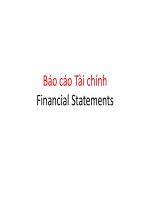Introduc corporate finance ch5
Bạn đang xem bản rút gọn của tài liệu. Xem và tải ngay bản đầy đủ của tài liệu tại đây (145.17 KB, 30 trang )
5-1
Valuation of Bonds and Stock
• First Principles:
– Value of financial securities = PV of expected
future cash flows
• To value bonds and stocks we need to:
– Estimate future cash flows:
• Size (how much) and
• Timing (when)
– Discount future cash flows at an appropriate rate:
• The rate should be appropriate to the risk presented by
the security.
McGraw-Hill/Irwin
Copyright © 2002 by The McGraw-Hill Companies, Inc. All rights reserved.
5-2
5.1 Definition and Example of a Bond
• A bond is a legally binding agreement between a
borrower and a lender:
– Specifies the principal amount of the loan.
– Specifies the size and timing of the cash flows:
• In dollar terms (fixed-rate borrowing)
• As a formula (adjustable-rate borrowing)
McGraw-Hill/Irwin
Copyright © 2002 by The McGraw-Hill Companies, Inc. All rights reserved.
5-3
5.1 Definition and Example of a Bond
• Consider a U.S. government bond listed as 6 3/8 of
December 2009.
– The Par Value of the bond is $1,000.
– Coupon payments are made semi-annually (June 30 and
December 31 for this particular bond).
– Since the coupon rate is 6 3/8 the payment is $31.875.
– On January 1, 2002 the size and timing of cash flows are:
$31.875
$31.875
$31.875
$1,031.875
6 / 30 / 09
12 / 31 / 09
1 / 1 / 02
6 / 30 / 02
McGraw-Hill/Irwin
12 / 31 / 02
Copyright © 2002 by The McGraw-Hill Companies, Inc. All rights reserved.
5-4
5.2 How to Value Bonds
• Identify the size and timing of cash flows.
• Discount at the correct discount rate.
– If you know the price of a bond and the size and
timing of cash flows, the yield to maturity is the
discount rate.
McGraw-Hill/Irwin
Copyright © 2002 by The McGraw-Hill Companies, Inc. All rights reserved.
5-5
Pure Discount Bonds
Information needed for valuing pure discount bonds:
– Time to maturity (T) = Maturity date - today’s date
– Face value (F)
– Discount rate (r)
$0
$0
$0
$F
T −1
T
0
1
2
Present value of a pure discount bond at time 0:
F
PV =
T
(1 + r )
McGraw-Hill/Irwin
Copyright © 2002 by The McGraw-Hill Companies, Inc. All rights reserved.
5-6
Pure Discount Bonds: Example
Find the value of a 30-year zero-coupon bond with a $1,000
par value and a YTM of 6%.
$0
$0
$0
$1,000
0$ 0$0,1$
01 22930
0
1
2
29
30
F
$1,000
PV =
=
= $174.11
T
30
(1 + r )
(1.06)
McGraw-Hill/Irwin
Copyright © 2002 by The McGraw-Hill Companies, Inc. All rights reserved.
5-7
Level-Coupon Bonds
Information needed to value level-coupon bonds:
– Coupon payment dates and time to maturity (T)
– Coupon payment (C) per period and Face value (F)
– Discount rate
$C
$C
$C
$C + $ F
T −1
T
0
1
2
Value of a Level-coupon bond
= PV of coupon payment annuity + PV of face value
C
1
F
PV = 1 −
+
T
r (1 + r ) (1 + r )T
McGraw-Hill/Irwin
Copyright © 2002 by The McGraw-Hill Companies, Inc. All rights reserved.
5-8
Level-Coupon Bonds: Example
Find the present value (as of January 1, 2002), of a 6-3/8
coupon T-bond with semi-annual payments, and a maturity
date of December 2009 if the YTM is 5-percent.
– On January 1, 2002 the size and timing of cash flows are:
$31.875
$31.875
$31.875
$1,031.875
6 / 30 / 09
12 / 31 / 09
1 / 1 / 02
6 / 30 / 02
12 / 31 / 02
$1,000
$31.875
1
PV =
1−
+
= $1,049.30
16
16
.05 2 (1.025) (1.025)
McGraw-Hill/Irwin
Copyright © 2002 by The McGraw-Hill Companies, Inc. All rights reserved.
5-9
Bond Rates and Yields
Suppose a $1,000 face value bond currently sells for
$932.90, pays an annual coupon of $70, and matures
in 10 years.
The coupon rate is the annual dollar coupon expressed
as a percentage of the face value:
Coupon rate = $___ /$_____ = 7.0%
The current yield is the annual coupon divided by the
price:
Current yield = $___ /_____ = 7.5%
McGraw-Hill/Irwin
Copyright © 2002 by The McGraw-Hill Companies, Inc. All rights reserved.
5-10
Bond Rates and Yields
The yield to maturity is the rate that makes the price of
the bond just equal to the present value of its future cash
flows.
How to find yield to maturity?
–
–
–
Trial and error
Approximation formula
Financial calculator
McGraw-Hill/Irwin
YTM = 8%
Copyright © 2002 by The McGraw-Hill Companies, Inc. All rights reserved.
5-11
5.3 Bond Concepts
1.
Bond prices and market interest rates move in opposite
directions.
2.
When coupon rate = YTM, price = par value.
When coupon rate > YTM, price > par value (premium
bond)
When coupon rate < YTM, price < par value (discount
bond)
3.
A bond with longer maturity has higher relative (%) price
change than one with shorter maturity when interest rate
(YTM) changes. All other features are identical.
4.
A lower coupon bond has a higher relative price change
than a higher coupon bond when YTM changes. All other
features are identical.
McGraw-Hill/Irwin
Copyright © 2002 by The McGraw-Hill Companies, Inc. All rights reserved.
5-12
YTM and Bond Value
$1400
Bond Value
When the YTM < coupon, the bond
trades at a premium.
1300
1200
When the YTM = coupon, the
bond trades at par.
1100
1000
800
0
0.01
0.02
0.03
0.04
0.05
0.06
0.07
6 3/8
0.08
0.09
0.1
Discount Rate
When the YTM > coupon, the bond trades at a discount.
McGraw-Hill/Irwin
Copyright © 2002 by The McGraw-Hill Companies, Inc. All rights reserved.
5-13
Bond Value
Maturity and Bond Price Volatility
Consider two otherwise identical bonds.
The long-maturity bond will have much more
volatility with respect to changes in the
discount rate
Par
Short Maturity Bond
C
McGraw-Hill/Irwin
Discount Rate
Long Maturity
Bond
Copyright © 2002 by The McGraw-Hill Companies, Inc. All rights reserved.
5-14
Bond Value
Coupon Rate and Bond Price Volatility
Consider two otherwise identical bonds.
The low-coupon bond will have much more
volatility with respect to changes in the
discount rate
High Coupon Bond
Discount Rate
Low Coupon Bond
McGraw-Hill/Irwin
Copyright © 2002 by The McGraw-Hill Companies, Inc. All rights reserved.
5-15
Bond Example:
Bond J has a 4% coupon and Bond K a 10% coupon. Both
have 10 years to maturity, make semiannual payments, and
have 9% YTMs. If market rates rise by 2%, what is the
percentage price change of these bonds? What if rates fall
by 2%?
McGraw-Hill/Irwin
Copyright © 2002 by The McGraw-Hill Companies, Inc. All rights reserved.
5-16
Percentage changes in bond prices
Bond prices and market rates
7%
9%
11%
Bond J
% Chg.
$786.81
(+16.60%)
$674.80
$581.74
(-13.79%)
Bond K
%Chg.
$1,213.19
(+13.9%)
$1,065.04
$940.25
(-11.72%)
The results above demonstrate that, all else equal, the price of the
lower-coupon bond changes more (in percentage terms) than the price
of the higher-coupon bond when market rates change.
McGraw-Hill/Irwin
Copyright © 2002 by The McGraw-Hill Companies, Inc. All rights reserved.
5-17
5.4 The Present Value of Common Stocks
• Dividends versus Capital Gains
• Valuation of Different Types of Stocks
– Zero Growth
– Constant Growth
– Differential Growth
McGraw-Hill/Irwin
Copyright © 2002 by The McGraw-Hill Companies, Inc. All rights reserved.
5-18
Case 1: Zero Growth
• Assume that dividends will remain at the same level
forever
Div1 = Div 2 = Div 3 =
• Since future cash flows are constant, the value of a zero
growth stock is the present value of a perpetuity:
Div 3
Div1
Div 2
P0 =
+
+
+
1
2
3
(1 + r ) (1 + r ) (1 + r )
Div
P0 =
r
McGraw-Hill/Irwin
Copyright © 2002 by The McGraw-Hill Companies, Inc. All rights reserved.
5-19
Case 2: Constant Growth
Assume that dividends will grow at a constant rate, g,
forever. i.e.
Div1 = Div 0 (1 + g )
Div 2 = Div1 (1 + g ) = Div 0 (1 + g ) 2
Div 3 = Div 2 (1 + g ) = Div 0 (1 + g ) 3
..
.
Since future cash flows grow at a constant rate forever,
the value of a constant growth stock is the present
value of a growing perpetuity:
Div1
P0 =
r−g
McGraw-Hill/Irwin
Copyright © 2002 by The McGraw-Hill Companies, Inc. All rights reserved.
5-20
Case 3: Differential Growth
• Assume that dividends will grow at different
rates in the foreseeable future and then will
grow at a constant rate thereafter.
• To value a Differential Growth Stock, we need
to:
– Estimate future dividends in the foreseeable future.
– Estimate the future stock price when the stock
becomes a Constant Growth Stock (case 2).
– Compute the total present value of the estimated
future dividends and future stock price at the
appropriate discount rate.
McGraw-Hill/Irwin
Copyright © 2002 by The McGraw-Hill Companies, Inc. All rights reserved.
5-21
Case 3: Differential Growth
• Assume that dividends will grow at rate g1 for N
years and grow at rate g2 thereafter
Div1 = Div 0 (1 + g1 )
Div 2 = Div1 (1 + g1 ) = Div 0 (1 + g1 )
..
.
2
Div N = Div N −1 (1 + g1 ) = Div 0 (1 + g1 )
N
Div N +1 = Div N (1 + g 2 ) = Div 0 (1 + g1 ) N (1 + g 2 )
..
.
McGraw-Hill/Irwin
Copyright © 2002 by The McGraw-Hill Companies, Inc. All rights reserved.
5-22
Case 3: Differential Growth
• Dividends will grow at rate g1 for N years and
grow at rate g2 thereafter
Div 0 (1 + g1 ) Div 0 (1 + g1 ) 2
…
0
1
2
Div 0 (1 + g1 ) N
Div N (1 + g 2 )
= Div 0 (1 + g1 ) N (1 + g 2 )
…
…
N
McGraw-Hill/Irwin
N+1
Copyright © 2002 by The McGraw-Hill Companies, Inc. All rights reserved.
5-23
Case 3: Differential Growth
We can value this as the sum of:
an N-year annuity growing at rate g1
C (1 + g1 )T
PA =
1 −
T
r − g1
(1 + r )
plus the discounted value of a perpetuity growing at rate
g2 that starts in year N+1
Div N +1
r − g2
PB =
N
(1 + r )
McGraw-Hill/Irwin
Copyright © 2002 by The McGraw-Hill Companies, Inc. All rights reserved.
5-24
Case 3: Differential Growth
To value a Differential Growth Stock, we can use
Div N +1
T
C (1 + g1 ) r − g 2
P=
+
1 −
T
N
r − g1
(1 + r ) (1 + r )
• Or we can cash flow it out.
McGraw-Hill/Irwin
Copyright © 2002 by The McGraw-Hill Companies, Inc. All rights reserved.
5-25
A Differential Growth Example
A common stock just paid a dividend of $2. The
dividend is expected to grow at 8% for 3 years, then
it will grow at 4% in perpetuity.
What is the stock worth?
McGraw-Hill/Irwin
Copyright © 2002 by The McGraw-Hill Companies, Inc. All rights reserved.









